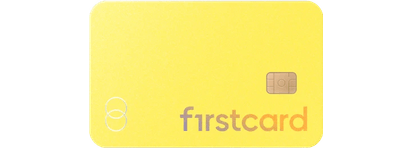updated: December 10, 2024
Opening a savings account for a child or teen is a great way to introduce them to the basics of saving and setting financial goals. When looking for a new account to open, you might start with your current bank first but it's helpful to expand your search. The best savings accounts for kids include options from online banks and credit unions and offer competitive interest rates and minimal fees.
Ready to help your child get into the savings habit? Learn which banks rate the best for helping kids and teens grow their money.
Open a savings account for your child
Our recommendations
Best for flexible interest
Best for flexible interest
Acorns Early
Monthly fee
$5 per kid; $10 for families with up to four kids
GoHenry gives parents flexibility in deciding how much interest to reward kids with as they work toward their savings goals.
Acorns Early is a debit card for kids and teens that allows parents to fund the interest on savings goals. Parents can set up prepaid interest in any amount and adjust it at any time. For instance, you could set the APY at 5%, 10%, 15%, or even higher.
As kids (or parents) make deposits to savings goals, balances will earn interest at that rate. This can be a great way to incentivize kids to save and keep them motivated to continue saving money regularly. Acorns Early is not free and there is a monthly fee to maintain an account. However, the monthly fee is $5 per kid, but it’s $5 per kid; $10 for families with up to four kids for up to four kids - so you get the third and fourth kids for free. You can also withdraw from any ATM at no extra cost.
Pros:
- Flexible APY that is controlled by the parent.
- Financial education is built into the app so kids can learn about money as they spend and save.
- Has an introductory bonus offer.
- Account is designed for kids as young as age 6.
- Offers customizable debit card designs.
Cons:
- Monthly fee applies per child.
- No option offered to deposit cash.
- Kids and teens get no investing options.
Best for high interest savings
Best for high interest savings
Step
Step offers a top-tier APY, making it easy for kids and teens to grow their savings with no minimums, no limits, and no fees.
Step is a digital banking platform that's designed to help teens spend, save, and build credit all before they turn 18. When parents open a Step account, their kids can get a debit card. More importantly, they earn a competitive APY on savings account balances. The current rate is on par with the best savings rates offered by online banks.
There is one caveat to earning interest on savings: Teens must have at least one qualifying direct deposit into their Step account per month. Aside from direct deposit, Step also offers a round-up feature that allows teens to round up debit card transactions automatically and roll the difference into savings.
Pros:
- Offers competitive savings rate, with no minimum balance requirement.
- Teens can build credit while developing good spending habits.
- Family accounts allow parents to easily track kids' spending.
- Built-in overdraft protection lets you avoid fees.
- Includes enhanced safety and security features.
Cons:
- Qualifying direct deposit is required to earn the advertised APY.
- Withdrawal limits apply.
- Is not available outside the U.S.
Best for saving and building credit
Best for saving and building credit
Firstcard
Monthly fee
$4.99, $8.99, or $12.99 per month or $48, $84, or $120 per year
First Card is ideal for teens and students who want to build credit while earning back some of what they spend each month.
FirstCard is a secured spending card for college students, with a twist. Balances in your FirstCard account earn interest so you can save while you're establishing your credit score.
The APY you'll earn depends on which type of First Card account you have.
- First Card – $4.99 monthly fee; 0.75% APY
- First Card+ – $8.99 monthly fee; 2.00% APY
The rates are on par with what some of the best high-yield savings accounts offer. There are no monthly fees, overdraft fees, or hidden fees of any kind. There's no minimum deposit required either and you can earn cash back on eligible purchases to help grow your savings balance.
Money in your FirstCard account is FDIC insured up to $250,000. So it's a safe, secure way for older teens and college students to learn the basics of building credit, spending, and saving.
Pros:
- Students get a bank account and a credit card in one.
- Has built-in controls to avoid overspending.
- No interest charged on purchases.
- Available to eligible international students.
Cons:
- Plus membership is required to earn the higher APY.
- Foreign transaction fees apply with free membership plans.
- ATM withdrawals carry a fee.
Best for credit union savings
Best for credit union savings
Alliant Credit Union Savigs
Min. deposit
$0 when you enroll in e-statements
Alliant gets kids started by paying their initial deposit for them and makes accessing savings convenient with a free ATM card.
If you're interested in opening a savings account at a credit union, Alliant is a great choice. Kids savings accounts earn a competitive APY that's well above the rate traditional banks typically pay for a standard savings account. Alliant pays the initial $5 deposit for you and there are no monthly maintenance fees when you opt in to e-statements.
This account is ideal for kids 12 and younger who are ready to start working toward their savings goals. Alliant offers an ATM card with this account so kids can deposit checks or cash, or make withdrawals. If you're also interested in a checking account, Alliant offers a teen checking option for older kids.
Pros:
- Has low opening deposit requirement.
- Savers earn an above-average rate.
- No monthly fees are charged when you opt in to e-statements.
- Provides online and mobile banking access.
- Kids are eligible for a teen checking account once they turn 13.
Cons:
- APY is not the highest you can find.
- Must be eligible to join Alliant Credit Union to open an account.
- Paper statement fee applies.
Best for saving toward multiple goals
Best for saving toward multiple goals
Capital One 360 Savings
Kids can save and earn interest with no fees or minimums and access their accounts through their personal online banking dashboard.
Capital One's kids savings account is a fee-friendly way to save while earning a decent APY. There are no minimum deposit requirements or monthly fees and parents can set up multiple savings accounts for the same child or different children in order to help them reach their goals.
You can easily link your child's savings account to your own Capital One accounts or to an account at a different bank for convenient transfers. Capital One lets parents and kids set up individual logins for online and mobile banking, which makes it easy to check balances or transfer funds on the go.
Pros:
- Automatic savings allow kids to easily add to their balance.
- Parents can transfer funds between linked accounts for added convenience.
- Has user-friendly mobile app and online banking experience.
- Provides top-rated customer service.
- You can bank online or at Capital One branches and cafes.
Cons:
- Rate is less competitive compared to other kids' savings accounts.
- Does not provide ATM card to withdraw cash.
- Branches and cafes are not available everywhere.
Best for automatic savings
Best for automatic savings
MPH Automatic Savings
The MPH First account allows kids and teens to get started with money management. They can upgrade to one of MPH's other accounts as their needs change.
MPH Bank's First account is designed for kids as young as 10 who are ready to learn the basics of how to spend (and save) wisely. This account includes a debit card, but kids can also set up savings goals inside the mobile app and deposits earn a generous interest rate. The round-up widget is an automatic savings feature that makes it easy to save any time you make a purchase.
Older teens can be paid up to two days early with the direct deposit feature and there are no monthly fees. Kids have access to more than 55,000 fee-free Allpoint ATMs nationwide. In addition, the First account integrates with Zelle for easy money transfers.
Pros:
- Parents and students can set account controls together.
- Kids can save for multiple goals in one place with round-ups.
- Has no fees and no minimums.
- Get paid up to two days early with direct deposit.
- Send and receive payments fee-free with Zelle.
Cons:
- APY is competitive, but not the highest rate kids can earn.
- Not available for kids under 10 years of age.
- Has no branches.
Best for saving and investing
Best for saving and investing
Greenlight Savings and Investing
Monthly fee
$5.99, $9.98, or $14.98
Greenlight empowers kids to learn about money management, including budgeting and saving, as well as investing, all in one place.
Greenlight is also a debit card for kids but it's more than that. With a Greenlight plan, kids can save money or invest it in the stock market. Kids earn 1% cash back deposited into savings when they spend with their Greenlight card and they can also get up to 5% in savings rewards monthly, depending on which level plan they have.
On top of those savings benefits, Greenlight offers a parent-paid interest option and automatic transfers for teens who want to save part of their paychecks regularly. Kids who are ready to step up their savings efforts can invest in fractional shares of stock or exchange-traded funds (ETFs), with no hidden fees.
Pros:
- Save and invest with as little as $1.
- Parental controls allow for flexibility.
- Built-in safety hub makes it easy for families to stay connected.
- Includes financial literacy tools for kids.
- No hidden fees.
Cons:
- Monthly fee applies.
- Limited benefits available with the Basic membership plan.
- There’s no option to make cash deposits.
Best savings accounts for children and teens compared
|
Acorns Early (Formerly GoHenry Debit Card) | | | |
| | | |
| | $4.99, $8.99, or $12.99 per month or $48, $84, or $120 per year | |
| | | $0 when you enroll in e-statements |
| | | |
| | | |
| | | |
Our methodology
We researched savings accounts for children and teenagers from top banks, including brick-and-mortar banks and online financial institutions. We also considered child savings account options offered by credit unions. In compiling our rankings, we researched the minimum opening deposit requirements, monthly fees, and annual percentage yield available. The best savings accounts for kids reflect the ones that offer the best combination of higher interest rates, low fees, and convenient access.
How to open a savings account for teenagers
If you'd like to open a savings account for a teen or child, choosing the right bank is the first step. Once you've done that, opening a savings account for kids is as simple as providing the bank with some required information.
Typically, banks will need the following to open an account for your child:
- Your name and your child's name
- Dates of birth for you and your child
- Social Security numbers for you and your child
- Your address and phone number
The bank may ask for additional documentation to verify your identity and your child's. Once you've filled in that information, you can move on to funding your new savings account.
Opening a child’s savings account at your current bank might be as simple as linking an existing account to it. If you're opening a savings account for a teen or child at a different bank, you'll need to link your account manually. You'll just need your account number and routing number to set up the initial transfer.
Keep in mind that if you want your child to be able to spend with a debit card, you may need to look into setting up a separate checking account or prepaid debit card account for that. Savings accounts typically have limits on how many withdrawals you can make per month. At many banks, the limit is six though it may be higher or lower, depending on which account you choose.
When to open a children's savings account
It's really never too soon to open a savings account for a child. The longer a child has to save, the more time they have to cash in on the power of compound interest.
A good time to open a children's savings account is when your child has some money to save. If they earn money from doing chores or receive cash gifts for birthdays and holidays, for instance, then a savings account can be a good place to keep it. Likewise, if you reward your kids with cash for good grades, then they can benefit from having a savings account of their own.
Keep in mind that banks may set a minimum age for when you can open a savings account for a child. For example, you might not be able to open a children's savings account until they turn six. In that case, you could still help your child build a savings habit using a piggy bank at home until they're old enough for a bank account.
How to choose a savings account for kids and teens
There are many savings accounts for children and teenagers out there but they aren't all equal. Shopping around can help you find the right savings account for your child's needs and goals.
Here are a few things to consider as you compare savings accounts for kids:
- Minimum opening deposit requirements
- Minimum age to open the account
- Interest rate and APY
- Monthly maintenance fees
- Other banking fees
- Deposit and withdrawal transaction limits
It's also helpful to look at what kind of features or tools a bank offers to encourage kids to save. Automatic savings features, calculators, or interactive games that teach children and teens about money are all things that can make a savings account more attractive. And some banks allow parents to deposit extra interest on their child’s savings as an encouragement to save.
Frequently asked questions (FAQs)
Should you open a savings account for your kid?
It can make sense to open a savings account for your child if they have their own money to save and you're ready to start teaching them about personal finance. A savings account can be a great way for kids to learn about setting financial goals and reaching them, while earning some interest on their money.
Do you pay taxes on children's savings accounts?
If a child's savings account earns interest, then you can expect your bank to issue you a Form 1099-INT at the end of the year. You'll have to report that interest as taxable income on your tax return.
What are the benefits of opening a kids' savings account?
Savings accounts are a safe, secure way for kids to save money and work toward their goals. As long as you're opening the account at an FDIC-insured bank, their money is protected and they can earn some interest as they save. More importantly, a savings account can be a useful way to teach kids the value of setting money aside regularly and they can also learn a little about how banking works.
*APY is subject to change. APY is updated as of Dec. 2, 2024.
The information presented here is created by TIME Stamped and overseen by TIME editorial staff. To learn more, see our About Us page.












